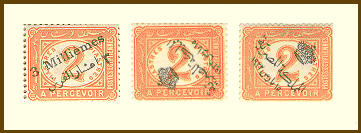

| Denominations: paras (pa), millièmes (m), piastres (p), Egyptian pound (£E) |
| Until 1888: 40pa = 1p. After 1888: 10m = 1p, 100p = £E1. |
| Postage Due Stamps, January 1, 1884, to 1965 |
 |
| Postage due stamps were introduced in 1884, all in the same style and colour as the first stamp illustrated.
Six values: 10pa, 20pa, 1p, 2p and 5p.
On August 1, 1886, four values - 10pa, 20pa, 1p and 2p -were reprinted on unwatermarked paper. On January 1, 1888, a new set was printed in the new millième currency: now each value is in a different colour. Five values: 2m, 5m, 1p, 2p and 5p. In April 1889 a new set was issued with a new design, as shown in the third stamp. Four values: 2m, 4m, 1p and 2p. This had a long run of 38 years until it was replaced by a new set on March 16, 1927. Reprints took place in 1932, 1938, 1941 and 1956. Over this period nine different values were issued and some colour changes took place. 2m, 4m, 5m, 6m, 8m, 10m, 12m, 20m and 30m. The last set of postage dues stamps was issued in August 1965, as seen in the right-hand stamp. Five values: 2m, 8m, 10m, 20m and 40m. |
 |
| Overprints were used on several of the postage due issues. The 3m on 2m surcharge (third design, top illustration; left above) was for the use of Egyptian troops serving in Sudan who were unable to purchase stamps to send home mail at the normal rate of 3m. The fee was paid by the recipient.
Two printings were made, one in 1889 and another in 1904 with minor changes in the overprint.
The Crown overprints are also found on this issue. Note that the vast majority of these were printed inverted: it is the upright version that is the rarer. The fourth stamp in the top illustration was also overprinted with "King of Egypt and Sudan, 16 October 1951" in 1952, as found on the definitives. |
|
|